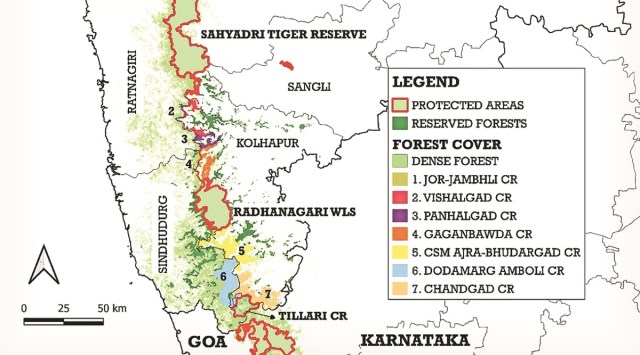- India
- International
In Sahyadri-Konkan corridor, tigers largely found in forested regions closer to Karnataka, Goa: Survey
The linear and montane forest landscape along the northern Western Ghats connects the Sahyadri Tiger Reserve (STR) in the state to the Kali Tiger Reserve (KTR) in Karnataka.
 A map depicting area under Sahyadri-Konkan corridor. (Courtesy: WCT)
A map depicting area under Sahyadri-Konkan corridor. (Courtesy: WCT)A year-long occupancy study in the Sahyadri-Konkan corridor, a 4,500 km human-dominated forest landscape, by the Wildlife Conservation Trust (WCT) has found that tiger distribution is largely concentrated in the southern end of the region, closer to the Goa and Karnataka border.
The linear and montane forest landscape along the northern Western Ghats connects the Sahyadri Tiger Reserve (STR) in the state to the Kali Tiger Reserve (KTR) in Karnataka. In between these two reserves, however, there are some parts that are human-dominated and narrower than one km, fragmented by cash crop plantations, mines, and other infrastructure that negatively impact the movement of the tigers.
The WCT study has found evidence of the presence of tigers in the forested regions closer to its source population, that is, Mhadei Sanctuary in Goa and Bhimgad Sanctuary-Kali Tiger Reserve in Karnataka. A source population is any place where the reproductive and survival rate of that particular species is high. Since it’s a protected area, the tigers in KTR are protected and are breeding. The excess population from that area then colonises the forest areas nearby, outside of the source.
While there has been no photographic evidence of female tigers in the Sahyadri Tiger Reserve, recently the state forest department found that eight tigers frequent the Sahyadri-Konkan corridor.
STR is spread over a 1,166 square kilometre area, and is western Maharashtra’s only tiger reserve, comprising Chandoli National Park and Koyna Wildlife Sanctuary.

A male tiger that was camera trapped first in 2018 in the STR has been repeatedly caught in the camera trap set up by Karnataka’s forest department at KTR in 2020, indicating that the animal travelled almost 200 km through this corridor. The only way a dispersing tiger can colonise the STR is through the Sahyadri-Konkan corridor.
The WCT study highlights the need for improved protection efforts in the corridor area. Tillari, for example, a critical bottleneck, which abuts the Mhadei (Goa) and Bhimgad (Karnataka) wildlife sanctuaries, has recorded sightings of tigers between 2014 and 2019 and was declared as a conservation reserve last year.
“The Sahyadri-Konkan corridor is crucial as it is the only way tigers can naturally colonise the STR and Radhanagari Wildlife sanctuary. Tigers are breeding in the KTR and Bhimgad in Karnataka and Mhadei Sanctuary in Goa and the only way they can naturally re-populate this landscape is if this corridor remains protected. It is a good sign that the state government and the forest department have declared a series of Conservation Reserves to protect this vital corridor,” said Girish Punjabi, a wildlife biologist at WCT who led the survey.
The study titled ‘Monitoring Change: A reassessment of large carnivore occupancy and distribution in the Sahyadri-Konkan Corridor’ was funded by Vinati Organics Limited and is part of a long-term scientific monitoring effort to understand and improve the status of large carnivores in the region. “These findings were shared with the forest department in STR. WCT along with the state forest department is helping to revise the tiger conservation plan,” Punjabi added.
In the last year, six new conservation reserves were notified in the region to protect the corridor. A conservation reserve works as a buffer zone between a protected area and wildlife sanctuary and helps in the movement of animals between the areas.
The National Tiger Conservation Authority (NTCA) along with the Wildlife Institute of India (WII) has also stressed the need to connect the tiger population across Goa and Maharashtra.
Leopards occupy 96% of the landscape
The study also included three other large carnivores — sloth bear, dhole and leopard. The study revealed that while tigers occupy 61 per cent of the landscape, dholes were spread across 81 per cent, leopards 96 per cent and sloth bears 65 per cent.
Apr 16: Latest News
- 01
- 02
- 03
- 04
- 05






































